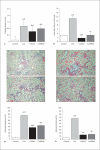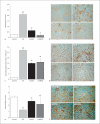Use of uric acid-lowering agents limits experimental cyclosporine nephropathy
- PMID: 22126908
- PMCID: PMC3254032
- DOI: 10.1159/000330274
Use of uric acid-lowering agents limits experimental cyclosporine nephropathy
Abstract
Background: Hyperuricemia frequently complicates cyclosporine (CsA) therapy. Previous studies have shown that hyperuricemia exacerbates interstitial and vascular lesions in the cyclosporine model. We tested the hypothesis that normalization of uric acid could prevent the development of cyclosporine toxicity.
Methods: CsA nephropathy was induced by administering CsA (15 mg/kg/day) for 7 weeks to rats on a low salt diet (CsA group). The effect of preventing hyperuricemia was determined by concomitant treatment with a xanthine oxidase inhibitor, allopurinol (CsAALP), or with a uricosuric, benzbromarone (CsABENZ), in drinking water. Control groups included vehicle-treated rats.
Results: CsA-treated rats developed mild hyperuricemia with arteriolar hyalinosis, tubular atrophy, striped interstitial fibrosis, increased cell proliferation and decreased VEGF expression. Treatment with allopurinol or benzbromarone limited renal disease, with reduced interstitial fibrosis, cell proliferation, macrophage infiltration, osteopontin expression and arteriolar hyalinosis, in association with restoration of VEGF expression. Both drugs provided comparable protection.
Conclusions: An increase in uric acid exacerbates CsA nephropathy in the rat. Concomitant treatment with allopurinol or benzbromarone reduced the severity of renal disease. The similar protection observed with both drugs suggests that the effect is associated more with lowering uric acid levels than the antioxidant effect of allopurinol.
Copyright © 2011 S. Karger AG, Basel.
Figures



Similar articles
-
Hyperuricemia exacerbates chronic cyclosporine nephropathy.Transplantation. 2001 Apr 15;71(7):900-5. doi: 10.1097/00007890-200104150-00014. Transplantation. 2001. PMID: 11349724
-
Pathogenesis of cyclosporine nephropathy: roles of angiotensin II and osteopontin.J Am Soc Nephrol. 1995 Oct;6(4):1186-96. doi: 10.1681/ASN.V641186. J Am Soc Nephrol. 1995. PMID: 8589285
-
Effect of lowering uric acid on renal disease in the type 2 diabetic db/db mice.Am J Physiol Renal Physiol. 2009 Aug;297(2):F481-8. doi: 10.1152/ajprenal.00092.2009. Epub 2009 May 20. Am J Physiol Renal Physiol. 2009. PMID: 19458127 Free PMC article.
-
[Uricosuric agent].Nihon Rinsho. 2008 Apr;66(4):743-7. Nihon Rinsho. 2008. PMID: 18409525 Review. Japanese.
-
Therapeutic Strategies for the Treatment of Chronic Hyperuricemia: An Evidence-Based Update.Medicina (Kaunas). 2021 Jan 10;57(1):58. doi: 10.3390/medicina57010058. Medicina (Kaunas). 2021. PMID: 33435164 Free PMC article. Review.
Cited by
-
Comorbidities in patients with crystal diseases and hyperuricemia.Rheum Dis Clin North Am. 2014 May;40(2):251-78. doi: 10.1016/j.rdc.2014.01.005. Epub 2014 Feb 19. Rheum Dis Clin North Am. 2014. PMID: 24703346 Free PMC article. Review.
-
Hyperuricemia, Acute and Chronic Kidney Disease, Hypertension, and Cardiovascular Disease: Report of a Scientific Workshop Organized by the National Kidney Foundation.Am J Kidney Dis. 2018 Jun;71(6):851-865. doi: 10.1053/j.ajkd.2017.12.009. Epub 2018 Feb 27. Am J Kidney Dis. 2018. PMID: 29496260 Free PMC article. Review.
-
The role of uric acid in kidney fibrosis: experimental evidences for the causal relationship.Biomed Res Int. 2014;2014:638732. doi: 10.1155/2014/638732. Epub 2014 May 5. Biomed Res Int. 2014. PMID: 24877124 Free PMC article. Review.
-
The ameliorative effects of virgin olive oil and olive leaf extract on amikacin-induced nephrotoxicity in the rat.Toxicol Rep. 2015 Sep 30;2:1327-1333. doi: 10.1016/j.toxrep.2015.09.007. eCollection 2015. Toxicol Rep. 2015. PMID: 28962475 Free PMC article.
-
Nephroprotective effects of Candesartan Cilexetil against Cyclosporine A-induced nephrotoxicity in a rat model.J Med Life. 2022 Dec;15(12):1553-1562. doi: 10.25122/jml-2021-0227. J Med Life. 2022. PMID: 36762326 Free PMC article.
References
-
- Bennett WM, De Mattos A, Meyer MM, Andoh TF, Barry JM. Chronic cyclosporine nephropathy. The Achille's heel of immunosuppressive therapy. Kidney Int. 1996;50:1089–1100. - PubMed
-
- Myers BD, Newton L. Cyclosporine induced chronic nephropathy: an obliterative microvascular renal injury. J Am Soc Nephrol. 1991;2(suppl 1):S45–S52. - PubMed
-
- Chapman JR, Harding NGL, Griffiths D, Morris PJ. Reversibility of cyclosporine nephrotoxicity after three months treatment. Lancet. 1985;19:128–130. - PubMed
-
- Gores PF, Fryd DS, Sutherland DER, Najarian JS, Simmons RL. Hyperuricemia after renal transplantation. Am J Surg. 1988;156:397–400. - PubMed
-
- Kahl LE, Thompson ME, Griffith BP. Gout in the heart transplant recipient: Physiological puzzle and therapeutic challenge. Am J Med. 1989;87:289–294. - PubMed
Publication types
MeSH terms
Substances
Grants and funding
LinkOut - more resources
Full Text Sources
Other Literature Sources
Medical
Research Materials

